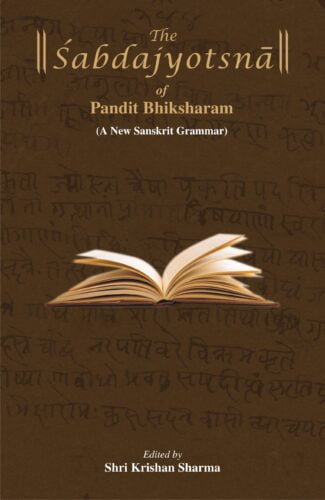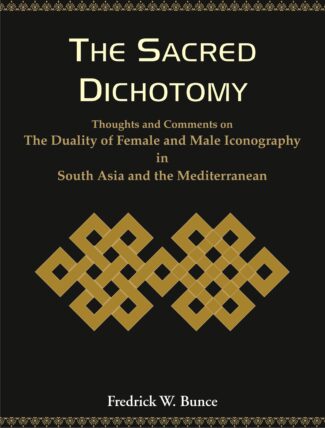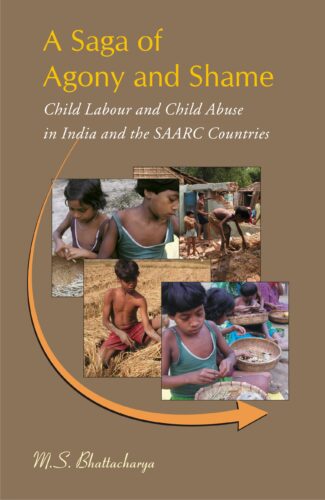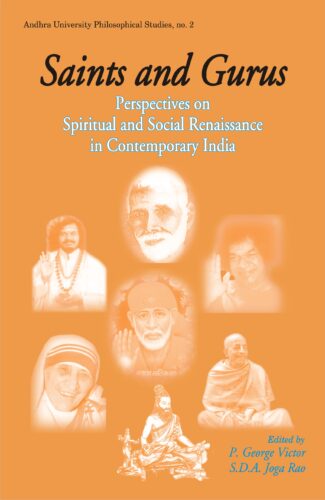Showing 811–820 of 1165 results

The book presents a collection of articles by Russian scholars on Indian culture, philosophy and religion, exploring the Vedas, Vaiseshika, Samkhya-Yoga and Mimamsa traditions. It also covers topics like modern interpretations of Vedanta, polemic of Vishishtadvaita and Advaita Vedanta.
This volume is a collection of articles, written by Russian scholars, on Indian philosophy, religion and culture. These articles explore key issues in the history of Indian philosophy, as well as the fundamentals of Indian religious thought and the problems of correlation between philosophy and religion in Indian tradition. The traditional schools of Indian philosophy, Samkhya and Yoga, Nyaya and Vaisheshika, Mimamsa and Vedanta, are analysed on the basis of their authoritative textual sources. Among other texts, Sankaras Brahma-sutra-bhashya and Ramanujas Gita-bhashya are studied in depth, with a special emphasis on the polemic between Vishishtadvaita and Advaita Vedanta. The later syncretic Nyaya-Vaisheshika is investigated on the basis of Annam Bhattas Tarkasamgraha and Tarkadipika as much as a critical analysis of Buddhist philosophy is undertaken through Shantarakshitas Tattvasamgraha. The modern Indian philosophy is also represented by highlighting the legacy of prominent personalities like Muhammad Iqbal and Sarvepalli Radhakrishnan. Due attention is given to the philosophy of non-violence of Gandhi and its relevance to the current problems of humankind. A comparative turn is represented by a paper on Leo Tolstoy and Sri Ramakrishna.
The book, as a whole, is an attempt to demonstrate the range and quality of contemporary Russian scholarship on Indian philosophical tradition and culture.

This book offers a study of Bhartrharis Vakyapadiya in an altogether modern (the post-Fregean) perspective on the philosophy of language. Bhartrharis analysis of language is presented methodically and in contemporary philosophical idiom.
It is the first ever study of the fifth-century scholar, Bhartriharis Vakyapadiya in an altogether modern, the post-Fregean, perspective on the Philosophy of Language. A uniquely original thinker in Indias splendid grammarians tradition, Bhartrihari overreached the limits of language analysis set by his predecessors like Panini and Patanjali constructing, as he did, a brilliant Philosophy of Language that sought to spell out, among other aspects, the subtle distinctions between the knowable and the sayable, between what is said and what is meant, between the semantics of everyday speech and literary discourse. Sadly, Bhartrihari has, through the centuries, suffered neglect, largely because the Grammarian School never figured in the six major systems of traditional Indian philosophy.
For the first time, this monograph tries to reinterpret Bhartriharis position as a philosopher, emphasizing the high relevance of his Vakyapadiya to modern Western thought. A reputed scholar of grammar, philosophy and Sanskrit studies, the author presents Bhartriharis analyses of language methodically, unbiased. And, significantly, in contemporary philosophical idiom with contextual focus on the views of modern Western philosophers: Frege, Wittgenstein, Grice, Austin, Davidson, Searle, Strawson and the like. Also offered here is a lucid exposition of the Sphota Theory.
Growing from Dr Patnaiks a decade-long research on Bhartriharis philosophy, the volume highlights not only ancient Indian contribution to the study of language, but the interconnectedness among its indigenous approaches to linguistics, philosophy, logic and aesthetics as well.

The sutras of Sabdajyotsna, composed by Pt. Bhiksharam, are arranged subject wise (according to prakarana) on the pattern of prakriya works. The author has succeeded in exposing the rules of Sanskrit grammar in lucid and clear diction. This pioneering attempt deserves recognition and appreciation in the academic circle.
Pt. Bihiksharam (18871975) composed the Sabdajyotsna with a view to teach Sanskrit grammar to an ordinary student in a simple style. The author adopts pratyahara, anuvritti, anubandha, etc. in his work to impart the abridgement on the pattern of Ashtadhyayi and Pratishakhyas. For this purpose, the author tries his best to simplify the tough process of learning Sanskrit grammar.
The sutras of the Shabdajyotsna are composed subject wise (according to prakarana) on the pattern of prakriya works. Only samjna- and sandhi-prakaranas of this work were published in 1958. The rest of the text in Devanagari remained in the form of manuscript lying unattended. The script, whatever traced, was made available to Prof. Shri Krishan Sharma for the editing purposes by his grandson. However, the samasa-prakarana and some portions of taddhita-prakarana still remain untraceable.
In spite of some minor gaps, the work deserves recognition and appreciation in the academic circle. The author of the Sabdajyotsna aimed at and indeed succeeded in fully exposing the rules of Sanskrit grammar in lucid and clear diction.
The work, a pioneering attempt of its kind, may very well be considered as a significant contribution to the tradition of Sanskrit grammar, benefiting students, teachers and researchers alike.

What is the doctrine of Sabdapramana (word as knowledge)? What is involved in hearing words? Is the understanding (Sabdabodha) derived through hearing utterances direct or indirect? Or does it depend on certain other conditions for its validation? These are just some of the questions that have emerged within the Hindu philosophical tradition which this book tries to answer.
Shabdapramana or Testimony is a formidable doctrine within Indian philosophy. A thorough investigation of this thesis is long overdue. What is shabdapramana (word as knowledge)? What is involved in hearing words? Is the understanding derived through hearing utterances direct or indirect? Does this peculiarly linguistic understanding (shabdabodha) amount to knowledge (prama), or does it depend on certain other conditions for its truth? Further, what sort of theories of meaning, understanding, and knowledge would be required to ground a successful shabdabodha as prama,> need careful attention. It is sometimes said that Indian thinkers had no particularly interesting theory of understanding. The present work sets out to address these issues issues that have engaged traditional and modern thinkers alike. Based on the classic text, Advaita Vedanta-paribhasha of Dharmarajadhvarindra (17th century), the analysis and arguments extend to the views of and criticisms from the Nyaya, Purva Mimamsa and the grammarian/linguistic schools within Indian philosophy, with a treatment of similar concerns in Western philosophy. There is a compelling thesis here that should be taken seriously in any philosophy. Long discarded as a distinct source of knowledge in Western philosophy, Testimony might be fruitfully re-examined. This could lead to mutual dialogue between philosophy and religion, and pave the way for critical metaphysics.

Dr. Samanta studies the sacred complex of Ujjain the ksetra itself, the Sipra river, bathing ghats, etc. He also investigates the linkages between this cultural centre and the cultural area and compares this sacred complex with others.
An anthropologist of wide repute here profiles Ujjain: a millennia-old, pilgrim centre that has been celebrated in history, legend and mythology. Located on the eastern bank of the Shipra in Malwas culture-area in Madhya Pradesh (Central India), it is a major link in the sacred network of the Hindu India. And has been traditionally venerated all across the subcontinent as one of the barely four sites for the periodic kumbha melas (religious congresses). This ancient city of Avantika (or Ujjayini), in fact, exhibits all that has gone into the shaping of Hindu ritualistic behaviour. Yet the crowning glory of Ujjain is centred around Mahakal: Lord Shivas temple, which is believed to be old beyond history. In opening out the cultural panorama of Ujjain, Dr. Samanta spotlights everything that reinforces the sanctity of this sacred complex: like, for instance, the ksetra itself, the Shipra river, bathing ghats, crematoriums, priests, preachers, pilgrims, mystifying rituals, religious discourses, festivals, yatras, pageants, ascetics congregations, and godmens institutions with meticulous description of the Mahakal temple which, generation after generation, has compelled country-wide attention. The book also investigates the linkages between this cultural centre and the cultural area, and how this sacred complex compares with its counterparts elsewhere in India. The author has, for this study, employed standard anthropological techniques, coupled with several spells of his fieldwork and his personal interviews with a number of key informants. Also included here is a painstakingly compiled glossary of non-English words.

This work examines the dichotomy of the male and female principles in South Asian and Mediterranean religious and cultural traditions: Hindu (Sanskritic), Buddhist, Greek, Latin and Western mystical traditions. It is a comparative study that explores the roots and nature of the dichotomy of the sexes in these traditions by delving into the sacred in terms of myth, concept, imagery and symbols. The book will be useful to all interested in comparative religion and cultural studies.
With numerous illustrations, this work examines the dichotomy of the male and female principles in South Asian and Mediterranean religious and cultural traditions: Hindu (Sanskritic), Buddhist, Greek, Latin and Western mystical traditions. It is a comparative study that explores the roots and nature of the dichotomy of the sexes in these traditions by delving into the sacred in terms of myth, concept, imagery and symbols. With extensive notes, it presents drawings of more than 60 symbols and concepts revolving around the male and the female principles. With sharp insights and reflecting painstaking research, it delves into the rich and complex meanings attached to the moon, sun, dark/light, phallus, rose, svastika, womb and weapons in various religions. The discussion shows the dichotomy of the sacred in all major religions, mostly the male being elevated and the female made subservient. It explains how dichotomies are all embedded within cultural icons and the dualism is often based upon a localised concept of a good and evil, or a right and wrong, polarity. The book will be useful to all interested in comparative religion and cultural studies.
“Sacred Thread offers a visual and three-language presentation of Pataðjali’s YogasÂtra. These 196 short sentences form the foundation for the philosophy and practice of Yoga. One of six ways of viewing the world, this Darœana emphasizes human potential. Acknowledging the troubles caused by ignorance, egotism, addiction, and negativity, Yoga urges the cultivation of opposites: gentle behavior (ahiÚsÀ), truth-telling (satya), honesty (asteya), sexual restraint (brahmacarya) and avoidance of consumerism (aparigraha). Combined with practices of body, breath, and meditation, Yoga brings understanding and freedom. Working with the original Sanskrit text, the book renders photographic images to understand Yoga philosophy along with translation and explanation in English as well as Hindi. Without a syllable to spare, the Sanskrit text encapsulates the meaning of life and the possibility of freedom in four chapters: SamÀdhi, SÀdhana, Powers, and Freedom. The daily street life of India places the entire spectrum of Pataðjali’s wisdom on display. The authors have chosen from thousands of images to match Pataðjali’s glimpses of reality with what can readily be seen in Pune or Varanasi or Delhi. The English translation seeks to convey Pataðjali’s concision without adding too much explanation. The process of Yoga requires the quieting of thoughts. By letting the words stand on their own, a sense of connection emerges, conveying the thread of Yoga wisdom. Yoga is now studied and practiced in more than four dozen universities throughout India. The Hindi translation provides yet another bridge for comprehending the wisdom of Yoga. This book will be useful for the many people training to be experts in Yoga.”

This book studies the way both Hinduism and Christianity have related sacrifice to the reality of the whole cosmos including the material universe Þ the Vedic view is seen as the best example of creation through sacrifice and the Christian cross as that of redemption through divine sacrifice.
In Hinduism, yajna has been at the centre of Vedic thought and practice, epic and Puranic literature. The Upanishads and the Bhagavad Gita add new dimensions to it through their spiritualization and interiorization and raising tapas and bhakti into sacrifice. The concept of sacrifice has been transformed into an ethical, spiritual and political value by Tilak and Gandhi in modern Hinduism. Christianitys interpretation of the mission of Jesus as a true, non-ritual sacrifice resulted in the gift of salvation to the world. The volume presents a deep understanding of the concept of sacrifice which is a central thought in Hinduism and Christianity. It studies the way the two traditions have related sacrifice to the reality of the whole cosmos including the material universe. The Vedic view is seen as the best example of creation through divine sacrifice, and the Christian Cross as that of redemption through divine sacrifice. The cosmic dynamism of the Eucharistic sacrifice is revealed through a study of four theologians. In this painstaking work sacrifice is examined as a complex universal phenomenon which has many-sided and multifaceted religious connotations. Thus it discovers the complementarity and interconnection between Vedism and Christianity. The book presents a new approach to study of religions and religious concepts. It would prove useful for scholars of religious studies.

This book offers a comprehensive account of child labour and child abuse in almost the entire South Asia. The state of child labour in the neighbouring countries like Bangladesh, Bhutan, Pakistan, Nepal and Sri Lanka vis-a-vis India, and possible remedies to the problem form part of this study.
In this book Dr M.S. Bhattacharya offers nothing less than a comprehensive account of child labour and child abuse in almost the entire South Asia. It began with the days of the Raj when newly set-up industries and plantations started employing children on a large scale to augment production which continued for a long time until trade union movements and resultant labour legislations restricted the employment of children in the factories and plantations. The state of child labour in the neighbouring countries like Bangladesh, Bhutan, Pakistan, Nepal and Sri Lanka vis-a-vis India, the economy of child labour, its socio-cultural roots, the treatment of children in the ancient world and possible remedies to the problem form part of this study. Further, in this book child abuse and juvenile delinquency, two inseparably linked phenomena have been discussed with a rare sense of aptness. This intensely directed study has mapped, perhaps for the first time, the problems of child labour, child abuse and juvenile delinquency with absorbing details.

The papers bring out the metaphysical, religious, ethical and social significance of the teachings of modern saints and gurus. They reveal the significance of their understanding of God, the nature of soul, spiritual equality, concepts like karma and jnana and importance of truth and non-violence in the present day.
Saints and gurus have been the guiding spirit of Indian culture. Since ancient times the Indian society has been benefited by their spiritual message. This book is an attempt to bring out the metaphysical, religious, ethical and social significance of the teachings of modern saints and gurus like Ramana Maharshi, Swami Prabhupada, Sri Chandrasekharendra Saraswati, Mahatma Gandhi, Mother Teresa, Sri Satya Sai Baba, Sri Bala Sivayogi, etc. Presented at the national seminar on Living Saints and Gurus of India, the essays that contained in this book reflect the Indian wisdom and philosophy as believed, practiced and preached by some modern saints of India. They throw light on the understanding of Hindu philosophy in general, and the cultivation of a proper perspective on God, the nature of soul, spiritual equality, importance of truth and non-violence and concepts like karma, Jnana and samsara, in particular. They also analyse the Biblical perspective on sainthood. Importantly, the book relates the significance of their thinking, addressing the imperative concerns of the present-day society in promoting universal peace and brotherhood. The reader will have complete satisfaction out of the time he spends with this book and will get immense pleasure and a life changing experience. This book is for all those interested in Indian religion and philosophy, particularly their growth and relevance in modern context.
| There are no products |